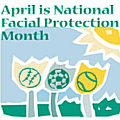April is National Facial Protection Month
Nearly 60,000 people injure their faces annually while playing baseball and more than 100,000 people suffer facial injuries from bicycle accidents. This month enhances public awareness of facial protection and specialized treatment for facial injuries, at least half of which are in children. Pediatric dentists, oral and maxillofacial surgeons and orthodontists—which are all ADA- recognized dental specialists—are sponsoring “April is National Facial Protection Month.” Their message is clear: Avoid sports injuries by wearing protective equipment. The American Academy of Pediatric Dentistry (AAPD), the American Association of Oral and Maxillofacial Surgeons (AAOMS) and the American Association of Orthodontists (AAO) encourage active people—children, parents, weekend warriors, professional athletes—to play it safe when getting outside this spring (or playing indoor sports). According to the National Institute of Health, childhood sports injuries may be inevitable but prevention does matter. For instance, football players can protect their faces with mouth guards and helmets. Likewise, basketball players should wear mouth guards and eye protection. A study published in the February 2003 Journal of the American Medical Association showed that players who used faceguards—devices made of plastic or metal that attached to baseball helmets—were 35 percent less likely to suffer facial injuries than non-users. Further, the Centers for Disease Control estimates that universal helmet use could save one life each day and prevent one head injury every four minutes. The Marshfield (Wisconsin) Clinic states that wearing protective eyewear can prevent 90 percent of eye injuries in the U.S. It seems the first step to facial protection is [...]





